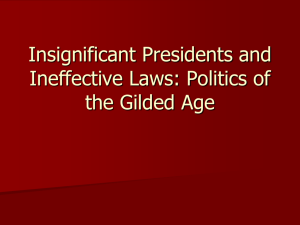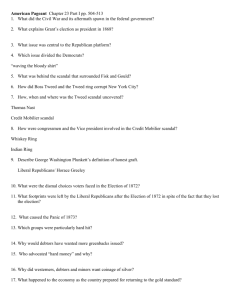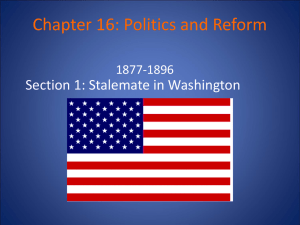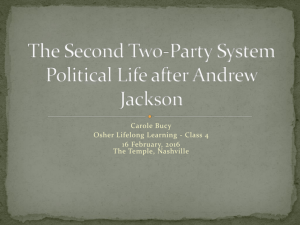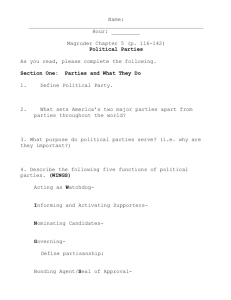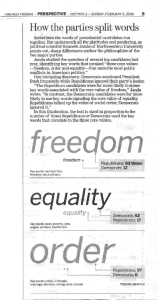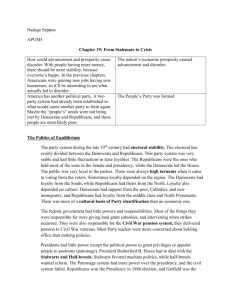Ch. 23 Notes Political Paralysis in the Gilded Age
advertisement
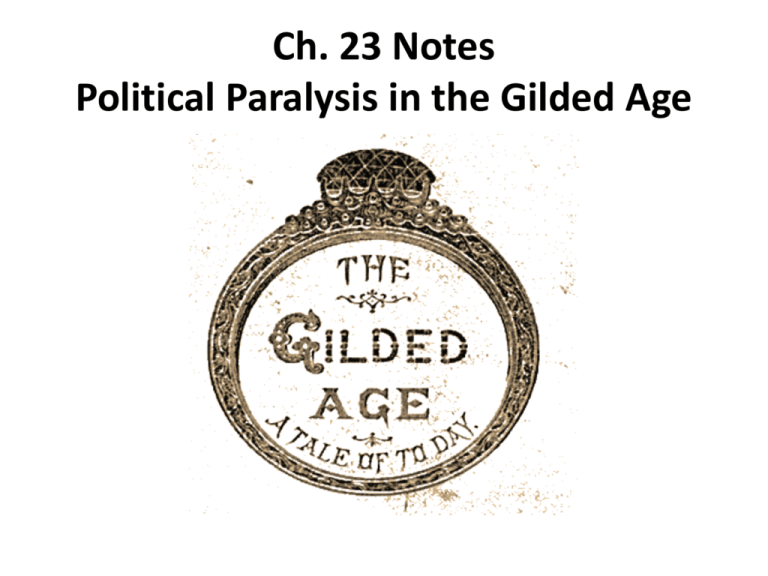
Ch. 23 Notes Political Paralysis in the Gilded Age The Gilded Age 1. Ulysses S. Grant will be elected president in 1868 – largely through the support of African American voters in the south and the Republican tactic of “waving the bloody shirt”, which reminded voters it was the Democrats who started the Civil War. 2. The problem was that Grant had no political experience and viewed the presidency as a reward from a grateful nation for winning the Civil War – he allowed his cabinet to handle running the country and many of the men he chose were corrupt. 3. During the Gilded Age, waste, speculation and corruption will be widespread in both business and government. Credit Mobilier 1. This scandal became public in 1872. 2. Union Pacific Railroad officials (responsible for building the continental railroad) established the Credit Mobilier construction company and then used it to build the railroad. 3. Afraid they might be discovered, they gave out shares of stock to numerous congressmen in exchange for their support and silence (including the vice president). 4. Eventually it became public – two congressmen were censured. Presidential Election of 1872 1. Because of corruption within Grant’s administration, a group of Republicans, known as the Liberal Republicans, broke from the party and promised to clean up the federal government – they also wanted to end the military occupation of the south. 2. The Liberal Republicans nominated Horace Greeley (editor of the New York Tribune) for president – the Democrats also endorsed Greely because the Republicans and Democrats didn’t have many policy differences – but he was such a controversial figure that Grant ended up winning his bid for reelection. Political Machines 1. The worst corruption was found at the state and local level. 2. Political machines would offer benefits to immigrants in exchange for votes – they would then use their political positions for personal gain. 3. The most famous/infamous example was Boss Tweed and Tammany Hall in New York City. 4. Eventually, Tweed was brought down, largely due to the New York Times and the political cartoons of Thomas Nast. The Panic of 1873 1. Industrialization was bringing major changes to U.S. society and the country’s economy. 2. In 1873, the over-expansion of factories, railroads and mines led to an economic panic (over 15,000 businesses went bankrupt). 3. During this time, “greenbacks”, or paper currency, became a major issue. 4. Greenbacks had been issued during the Civil War but the treasury had been slowly withdrawing them from circulation. 5. Many people wanted more greenbacks put into circulation to stimulate the economy – those that opposed the plan did so because of the inflation that the paper currency created. 6. Others not only wanted more greenbacks in circulation, they wanted the government to use silver to back them up – Grant refused this plan. Gilded Age Politics 1. During the Gilded Age, there was little difference between the Republicans and Democrats, but there were always high voter turnouts in the elections. 2. One reason was that both parties used patronage (spoils system) to reward their supporters. Political Parties of the Gilded Age Democratic Bloc Republican Bloc White southerners (preservation of white supremacy) Northern whites (pro-business) Catholics Northern Protestants Recent immigrants (esp. Jews) Urban working poor (pro-labor) Most farmers African Americans Old WASPs (support for anti-immigrant laws) Most of the middle class The Presidential Election of 1876 1. In 1876, the Republicans nominated Rutherford B. Hayes and the Democrats nominated Samuel J. Tilden. 2. In a close race, three southern states (still under the control of the Republicans due to the presence of the U.S. army in the south) delivered contested results. 3. Louisiana, South Carolina and Florida ended up submitting two sets of returns, one Democratic and one Republican. 4. Both candidates claimed victory and both refused to step aside. 5. In the end, a special commission (comprised of 8 Republicans and 7 Democrats) came up with the Compromise of 1877. 6. Under the Compromise, Hayes received the election - in return he agreed to remove all federal troops from the south. 7. This is viewed as the official end of Reconstruction. The Presidential Election of 1876 The “Redeemers” 1. White southern Democrats, calling themselves Redeemers, slowly began retaking control of the state governments of the south. 2. They slowly disfranchised African Americans through the use of poll taxes, literacy tests and economic and physical intimidation. 3. The southern states also began to legally segregate the south through Jim Crow laws – taking de facto segregation and turning it into de jure segregation. 4. In 1896, with the case of Plessey v. Ferguson, the U.S. Supreme Court decided that under the 14th Amendment, having separate facilities was legal as long as they were equal (separate but equal doctrine). The Railroad Strike of 1877 1. Labor unions were growing in number in the northeast because of the low pay, long hours and terrible working conditions faced by laborers. 2. In 1877, the four largest railroads (the first major industry/monopoly) cut salaries by 10%. 3. When this occurred, railroad workers went on strike – 4. Eventually, President Hayes called in federal troops to break up the strike and get the railroads moving again – 100 people were killed and 2/3’s of the nations railroads were idle. 5. Throughout the Gilded Age, government intervention between the labor unions and big businesses always favored big business. Presidential Election of 1880 1. In this election, the Republicans were divided. 2. The Stalwarts, or old Republicans, supported the use of the patronage system. 3. The Halfbreeds, of Liberal Republicans, were in favor of government reform. 4. To keep the party together, the Republicans nominated James Garfield (a Halfbreed) for president and Chester A. Arthur (a Stalwart) for vice president. 5. The Democrats nominated a Civil War hero, Winfield Scott Hancock. 6. It was a close election in the popular votes but the Republicans won comfortably in the electoral votes. The Assassination of Garfield 1. Garfield was shot in the back in a Washington D.C. railroad station by Charles Guiteau. 2. Guiteau was unhappy that he didn’t get a government job after helping support Garfield in the election. The Pendleton Act 1. When Arthur took over as president, he will sign into law the Pendleton Act. 2. The Pendleton Act created the civil service and required people applying for federal jobs to take a competitive examination to prove they could handle the requirements of the job. 3. By the year 1900, over half of all federal jobs fell within the civil service area. 4. The Pendleton Act made government officials more competent and accountable. 5. The problem it created is that it led political leaders to turn to other avenues for support, and they will find it with business leaders and big corporations. The Chinese Exclusion Act 1. Another major piece of legislation passed during Arthur’s time in office was the Chinese Exclusion Act. 2. This law was an effect of the nativist sentiments sweeping through the country. 3. In the west, the Chinese had been used as laborers in the gold mines and in building the transcontinental railroad. 4. Now that the railroad was finished, they were viewed as competition for jobs that Americans should have, so they were banned from entering the nation. Presidential Election of 1884 1. In this election, the Republicans nominate James G. Blaine, the leader of the halfbreeds. 2. The Democrats nominate Grover Cleveland. 3. During the campaign, the Mulligan Letters are made public and implicate Blaine in corruption with a western railroad company. 4. A group of republicans, called the mugwumps, will throw their support to Cleveland and he will end up winning the election. The Tariff 1. By this time, the tariff has become the major political issue of the day. 2. The Republicans, who are viewed as the party for big business, want a high, protective tariff. 3. The Democrats, who get their support from other groups, want the tariff’s lowered. 4. Cleveland will lower the tariff’s during this time. The Presidential Election of 1888 1. In this election, the Democrats will run Grover Cleveland. 2. The Republicans will run Benjamin Harrison, the grandson of William Henry Harrison. 3. The main issue is the tariff. 4. Cleveland wins the popular vote but fails to win the electoral vote (because he loses his home state of New York). The McKinley Tariff 1. Under Harrison, the McKinley Tariff will be passed – it’s the highest protective tariff the country has ever had. 2. The tariff creates such a huge surplus that Congress will spend over one billion dollars for the first time ever – known as the Billion Dollar Congress. 3. This hurts Harrison though and will allow Cleveland to win again in 1892, making him the only president to win two, nonconsecutive terms of office. The Populist 1. The Populist, or People’s Party, grows out of the discontent of farmers in the Midwest. 2. The Populist wanted government ownership of railroads (and the means of communication), the unlimited coinage of silver (to put more money in circulation), an income tax (so we could get rid of the tariff), a one-term presidency, the direct election of Senators (they were chosen by state legislatures, which were dominated by political machines) and immigration restrictions. 3. The Populist didn’t gain much support from the south because white Democrats convinced poor white farmers the Populists wanted to give equality to African Americans. 4. It also didn’t gain much support from the labor movement because the unlimited coinage of silver would cause inflation.
